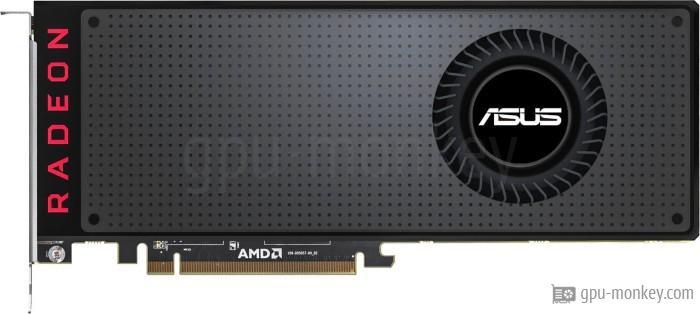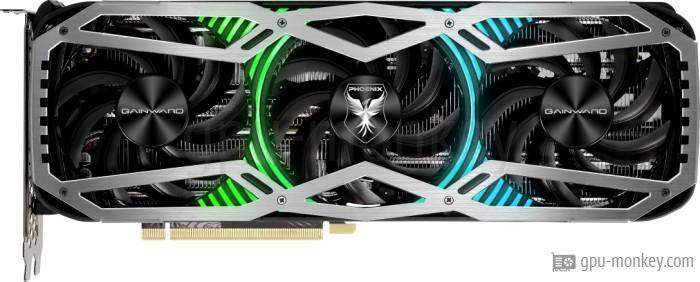
ASUS Radeon RX Vega 64
vs
Gainward GeForce RTX 3060 Ti Phoenix V1 LHR
GPU comparison with benchmarksIn the gpu comparison between the ASUS Radeon RX Vega 64 and the Gainward GeForce RTX 3060 Ti Phoenix V1 LHR, we compare both the technical data and the benchmark results of the two graphics cards.
|
||
GPUThe ASUS Radeon RX Vega 64 is based on the AMD RX Vega 64 and has 4096 texture shaders and 64 execution units. Gainward GeForce RTX 3060 Ti Phoenix V1 LHR is based on NVIDIA GeForce RTX 3060 Ti LHR, which has 4864 shaders and 38 execution units. |
||
| ASUS Radeon RX Vega 64 | GPU | Gainward GeForce RTX 3060 Ti Phoenix V1 LHR |
| AMD RX Vega 64 | Based on | NVIDIA GeForce RTX 3060 Ti LHR |
| Vega 10 XT | GPU Chip | GA104-202-A1 |
| GCN 5 | Architecture | Ampere |
| 64 | Streaming Multiprocessors | 38 |
| 4096 | Shader | 4864 |
| 64 | Render Output Units | 80 |
| 256 | Texture Units | 152 |
| 0 | Raytracing Cores | 38 |
MemoryThe ASUS Radeon RX Vega 64 has 8 GB of graphics memory of the type HBM2 and achieves a memory bandwidth of 484 GB/s. The Gainward GeForce RTX 3060 Ti Phoenix V1 LHR can access 8 GB GDDR6 graphics memory and thus achieves a memory bandwidth of 448 GB/s. |
||
| 8 GB | Memory Size | 8 GB |
| HBM2 | Memory Type | GDDR6 |
| 0.945 GHz | Memory Clock | 1.750 GHz |
| 1.9 Gbps | Memory Speed | 14.0 Gbps |
| 484 GB/s | Memory bandwidth | 448 GB/s |
| 2048 bit | Memory Interface | 256 bit |
Clock SpeedsThe ASUS Radeon RX Vega 64 clocks in the base with up to 1.247 GHz. The base frequency of the Gainward GeForce RTX 3060 Ti Phoenix V1 LHR is 1.410 GHz. |
||
| 1.247 GHz | Base Clock | 1.410 GHz |
| 1.546 GHz | Boost Clock | 1.665 GHz |
| Avg (Game) Clock | 1.67 GHz | |
| Yes | Overclocking | Yes |
Thermal DesignThe TDP (Thermal Design Power) of the ASUS Radeon RX Vega 64 is 295 W. The graphics card is supplied with energy via the 2 x 8-Pin connector. The Gainward GeForce RTX 3060 Ti Phoenix V1 LHR has a TDP of 220 W and is supplied with the required energy via 2 x 8-Pin PCIe power connectors. |
||
| 295 W | TDP | 220 W |
| -- | TDP (up) | -- |
| 100 °C | Tjunction max | 93 °C |
| 2 x 8-Pin | PCIe-Power | 2 x 8-Pin |
Cooler & FansThe ASUS Radeon RX Vega 64 has a total of 1 Radial fans. The Gainward GeForce RTX 3060 Ti Phoenix V1 LHR has 3 Axial fans to cool the GPU and memory. |
||
| Radial | Fan-Type | Axial |
| 1 x 70 mm | Fan 1 | 3 x 90 mm |
| -- | Fan 2 | -- |
| Air cooling | Cooler-Type | Air cooling |
| dB | Noise (Idle) | 0 dB |
| -- | Noise (Load) | 37 dB |
ConnectivityIn the connectivity category, we recorded the number of ports on a graphics card. A total of 4 screens can be connected to the ASUS Radeon RX Vega 64. The Gainward GeForce RTX 3060 Ti Phoenix V1 LHR supports a maximum of 4 screens. |
||
| 4 | Max. Displays | 4 |
| 2.2 | HDCP-Version | 2.3 |
| 1x HDMI v2.0b | HDMI Ports | 1x HDMI v2.1 |
| 3x DP v1.4 | DP Ports | 3x DP v1.4a |
| -- | DVI Ports | -- |
| -- | VGA Ports | -- |
| -- | USB-C Ports | -- |
FeaturesetThe ASUS Radeon RX Vega 64 supports a maximum resolution of 7680x4320 pixels. The maximum resolution of the Gainward GeForce RTX 3060 Ti Phoenix V1 LHR is 7680x4320 pixels. |
||
| 7680x4320 | Max. resolution | 7680x4320 |
| 12_1 | DirectX | 12_2 (Ultimate) |
| No | Raytracing | Yes |
| Yes | DLSS / FSR | Yes |
| No LED lighting | LED | Addressable LED |
Supported Video CodecsThe support and acceleration of certain video codecs directly in the graphics card reduces the load when playing or creating videos. |
||
| Decode / Encode | h264 | Decode / Encode |
| Decode / Encode | h265 / HEVC | Decode / Encode |
| No | AV1 | Decode |
| Decode | VP8 | Decode |
| Decode / Encode | VP9 | Decode |
DimensionsThe ASUS Radeon RX Vega 64 is 280 mm long, 127 mm high and 40 mm wide. The Gainward GeForce RTX 3060 Ti Phoenix V1 LHR is 294 mm long, 112 mm high and -- wide. |
||
| 280 mm | Length | 294 mm |
| 127 mm | Height | 112 mm |
| 40 mm | Width | -- |
| 2 PCIe-Slots | Width (Slots) | 3 PCIe-Slots |
| -- | Weight | -- |
| PCIe 3.0 x 16 | GPU Interface | PCIe 4.0 x 16 |
Additional dataThe ASUS Radeon RX Vega 64 was released in Q3/2017 at a price of 499 $ (Reference). The Gainward GeForce RTX 3060 Ti Phoenix V1 LHR was introduced in Q2/2021 at a price of 449 $. |
||
| RXVEGA64-8G | Part-no | NE6306T019P2-1041X |
| Q3/2017 | Release date | Q2/2021 |
| 499 $ (Reference) | Launch Price | 449 $ |
| 14 nm | Structure size | 8 nm |
| -- | Documents | data sheet |
Rate these graphics cards now
Benchmark results
3DMark Benchmark (DirectX, Raytracing)
3DMark is a benchmark program that determines the performance of certain components of a computer and then reports the performance as a numerical value.
Time Spy Extreme Graphics score

|
ASUS Radeon RX Vega 64
8 GB HBM2 |
||

|
Gainward GeForce RTX 3060 Ti Phoenix V1 LHR
8 GB GDDR6 |
||
Port Royal (Raytracing)

|
Gainward GeForce RTX 3060 Ti Phoenix V1 LHR
8 GB GDDR6 |
||
Speed Way Graphics Score (Raytracing)

|
Gainward GeForce RTX 3060 Ti Phoenix V1 LHR
8 GB GDDR6 |
||
Cyberpunk 2077
Cyberpunk 2077 was developed by CD Projekt Red and is based on the development studio's own REDengine 4. Ray tracing is switched off in our benchmarks.
3840x2160 (2160p)

|
Gainward GeForce RTX 3060 Ti Phoenix V1 LHR
8 GB GDDR6 |
||
2560x1440 (1440p)

|
Gainward GeForce RTX 3060 Ti Phoenix V1 LHR
8 GB GDDR6 |
||
1920x1080 (1080p)

|
Gainward GeForce RTX 3060 Ti Phoenix V1 LHR
8 GB GDDR6 |
||
The Last of Us Part 1
The Last of Us Part One is a game released by Sony in June 2013 exclusively for the Playstation and released for the PC in early 2023. The benchmark values here were determined at high details.
3840x2160 (2160p)

|
Gainward GeForce RTX 3060 Ti Phoenix V1 LHR
8 GB GDDR6 |
||
2560x1440 (1440p)

|
Gainward GeForce RTX 3060 Ti Phoenix V1 LHR
8 GB GDDR6 |
||
1920x1080 (1080p)

|
Gainward GeForce RTX 3060 Ti Phoenix V1 LHR
8 GB GDDR6 |
||
Battlefield 5
Battlefield 5 is a visually stunning game that is ideal as a graphics card benchmark. We test the game with maximum details on Windows 10.
3840x2160 (2160p)

|
ASUS Radeon RX Vega 64
8 GB HBM2 |
||

|
Gainward GeForce RTX 3060 Ti Phoenix V1 LHR
8 GB GDDR6 |
||
2560x1440 (1440p)

|
ASUS Radeon RX Vega 64
8 GB HBM2 |
||

|
Gainward GeForce RTX 3060 Ti Phoenix V1 LHR
8 GB GDDR6 |
||
1920x1080 (1080p)

|
ASUS Radeon RX Vega 64
8 GB HBM2 |
||

|
Gainward GeForce RTX 3060 Ti Phoenix V1 LHR
8 GB GDDR6 |
||
Geekbench 6 (OpenCL, Vulkan, Metal)
Geekbench 6 is a cross-platform benchmark for main processors, which also carries out 3 different graphics benchmarks and outputs them in the form of a numerical value.
Geekbench 6 - OpenCL

|
ASUS Radeon RX Vega 64
8 GB HBM2 |
||

|
Gainward GeForce RTX 3060 Ti Phoenix V1 LHR
8 GB GDDR6 |
||
Geekbench 6 - Vulkan

|
ASUS Radeon RX Vega 64
8 GB HBM2 |
||

|
Gainward GeForce RTX 3060 Ti Phoenix V1 LHR
8 GB GDDR6 |
||
Geekbench 6 - Metal

|
ASUS Radeon RX Vega 64
8 GB HBM2 |
||
FP32 Performance (Single-precision TFLOPS)
The theoretical computing power of the graphics card with single precision (32 bit) in TFLOPS indicates how many trillion FP32 floating point operations the graphics card (GPU) can perform per second.
FP32 (TFLOPS)

|
ASUS Radeon RX Vega 64
8 GB HBM2 |
||

|
Gainward GeForce RTX 3060 Ti Phoenix V1 LHR
8 GB GDDR6 |
||
Popular comparisons











